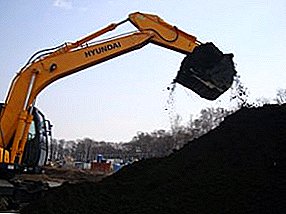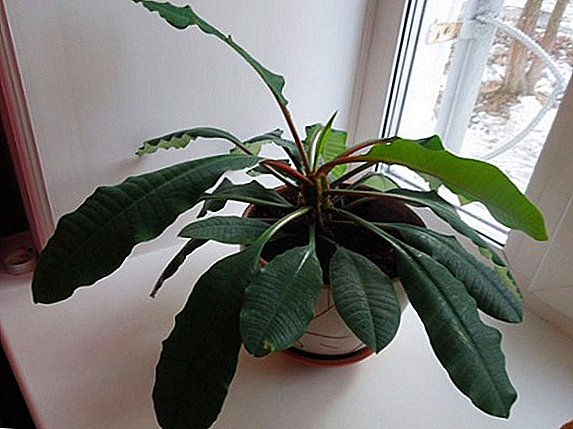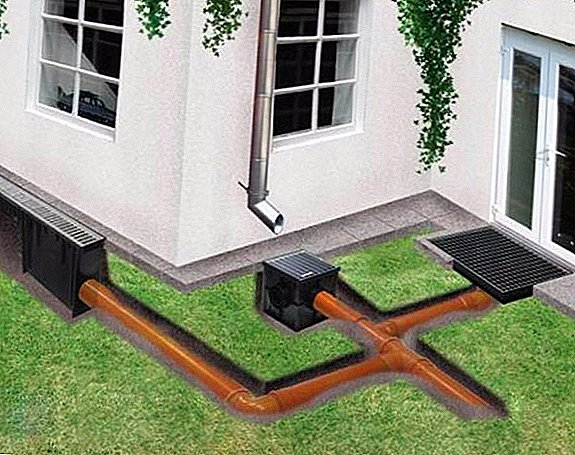 The modern summer resident almost daily faces a number of problems arising on his own plot. Pest control, fertilizer seedlings, care for them and watering - a symbiosis that represents the daily picture of the summer resident. However, the most significant and destructive problem is excessive wetting of the site. This seemingly insignificant problem actually predetermines the existence of problems with the overall yield of the plot. Fortunately, gardeners are not alone in this problem, and our article will fully explain what are the most effective methods of drying the site from groundwater.
The modern summer resident almost daily faces a number of problems arising on his own plot. Pest control, fertilizer seedlings, care for them and watering - a symbiosis that represents the daily picture of the summer resident. However, the most significant and destructive problem is excessive wetting of the site. This seemingly insignificant problem actually predetermines the existence of problems with the overall yield of the plot. Fortunately, gardeners are not alone in this problem, and our article will fully explain what are the most effective methods of drying the site from groundwater.
Excessive wetting of the site, what to do
Excess water on the land plot can create a lot of problems, the main among which is the deterioration of germination of fruits and vegetables and the beginning of their rotting. In order to save your own summer cottage from inevitable problems, of course, it is necessary to take urgent measures, making a choice in favor of one or another method of water drainage.
- Assistance to a qualified team. As with any other problem, excessive wetting of the area may be decided by specialized experts having a specialized device. They certainly know how to properly drain the dacha, but, as a rule, professionals simply pump out water with pumps - the effect is momentary, but not durable.

- Sand application to the soil. The method consists in sanding the soil, that is its uniform mixing with sand in equal proportion. This method not only solves the problem, but also significantly improves the quality of the land, increasing its yield. The problem of the technique is the need for a large amount of sand and labor-intensive work.
- Creating a drainage. The installation of the drainage system is the creation of special ditches throughout the site, their further integration and the final drainage of water. The method is highly efficient, affordable and cost-effective. Moreover, to date, the experience of summer residents, which consists in how to make drainage, can be freely studied and made with your own hands. Due to various reasons and peculiarities, experts strongly recommend choosing this way of solving the problem with excess moisture.
- Open ditches. The system of removal of excess water from the site is solved by creating (digging) open ditches at a slight angle. Thus, water stagnating at the site enters the diversion ditches and is discharged into the common drain hole or outside the territory of the site. A significant drawback of such ditches is their rapid shedding and pollution - efficiency is observed only in the first weeks.
- Planting trees. Separate trees, such as willow and birch, for example, help significantly to clean marshlands. Trees, due to own water consumption, effectively dry the area. However, drying the site with the help of trees is a long-term process that can not always suit the summer resident. Moreover, trees create an extra shadow at the dacha, which is also undesirable in conditions of limited cottage sizes.

- Bulk soil and raising the level of the beds. The solution to the problem in this case lies exclusively in the purchase of soil and increase the total land level in the dacha. This option is certainly effective, but expensive and time-consuming, which in real conditions does not allow to consider it as the main one.
What is a drainage system, types of structures and their features
Drainage cottages - one of the most important components of the created engineering communications on the site. It helps the groundwater, rainwater and melt water not to linger on the site and, accordingly, prevents waterlogging. In fact, there are many ways to clean the area from water, but the following types of drainage have proven themselves best:
- Surface drainage (open type);
- Deep drainage (closed type).
Surface drainage
Surface drainage at the dacha represents a network of open channels, the diverting and receiving areas of which are carried out at a certain angle, which prevents the crumbling of the soil. This method of protection against excess moisture in the territory of the summer cottage is perfectly suited for removing water from tracks, drains, roofs and canopies. Regarding groundwater, surface drainage at the dacha is effective only in the case of large quantities and high levels, since water is collected exclusively on the surface of the ground.
 On the constructive side The greatest efficiency of surface drainage is observed with a ditch width of at least 30-40 cm and an angle of inclination of the side walls of at least 30 degrees, which ensures the normal collection of water from the site. Surface drainage exists point and linear. The first is intended for local collection of water at selected drain points. The point surface drainage is connected to drainage drainage channels, i.e. linear drainage. The point drainage of the suburban area, as a rule, is a kind of drain hole, with the help of which further water is removed from the area.
On the constructive side The greatest efficiency of surface drainage is observed with a ditch width of at least 30-40 cm and an angle of inclination of the side walls of at least 30 degrees, which ensures the normal collection of water from the site. Surface drainage exists point and linear. The first is intended for local collection of water at selected drain points. The point surface drainage is connected to drainage drainage channels, i.e. linear drainage. The point drainage of the suburban area, as a rule, is a kind of drain hole, with the help of which further water is removed from the area.
The device of such holes is incredibly simple, and their effectiveness is ensured only by sufficient dimensions and proper organization of the collection and removal of water. Elements of linear surface drainage are represented by ditches and channels evenly located in the areas of the greatest accumulation of groundwater and other waters. In fact, linear and point surface drainage is best used together.
Important!The effectiveness of surface drainage is ensured solely by the correctness of the creation of such a system and its regular maintenance, as the ditches quickly become clogged and crumble.
Deep drainage
Based on the name, it becomes clear that Distinctive feature of the deep drainage is the location underground. Such a system, as well as surface drainage, is intended to divert groundwater and rainwater from the dacha. This type of drainage usually, selected on the basis of the geographical location of the problem. Thus, the closed type of water drainage is most appropriate in lowlands and places with naturally elevated levels of soil moisture.
In view of the design features, it is advisable to divide the deep drainage into: 
- Horizontal;
- Vertical;
- Combined.
Combined design - a combination of horizontal and vertical drainage types. Using a combination is also not always advisable. As the main channels, pipes with holes previously made in them are used to absorb water. The depth of such channels is about 40-50 cm.
Did you know?Depth drainage is the only method to control the increased soil moisture and groundwater, in which the entire land plot can be cultivated and planted.
How to make a surface drainage with your own hands
The surface drainage of the summer cottage with your own hands can be done quite simply, while ensuring the high efficiency of the activities carried out. Immediately it is worth noting that This method is the most economical and simple. As mentioned earlier, surface drainage includes a combination of linear and point drainage systems. Thus, in the process of creating an open drainage of the dacha, it is necessary to install water inlets, drainage systems, protective elements and dig ditches.
 The most universal type of open drainage is a linear system that provides an adequate level of comprehensive protection. This design is simple and does not require special skills. The basis of the implementation of this method is the proper preparation of a plan for the dacha plot - it should reflect all the buildings, trees, and, of course, the places where the rain and groundwater are collected most. On this basis, further it is necessary to note the path of diversion of water into the drain hole or beyond the territory of the site.
The most universal type of open drainage is a linear system that provides an adequate level of comprehensive protection. This design is simple and does not require special skills. The basis of the implementation of this method is the proper preparation of a plan for the dacha plot - it should reflect all the buildings, trees, and, of course, the places where the rain and groundwater are collected most. On this basis, further it is necessary to note the path of diversion of water into the drain hole or beyond the territory of the site.
Did you know?Often experienced gardeners, solving the problem of excess water in the country ground with the help of drain holes, create themselves a sufficiently large supply of water, later used for irrigation. This is realized by concreting the pit and installing a pump into it.
Making a similar plan, remember: water should be discharged in the direction of the slope. In addition, in order to minimize the used area of the soil, water diversion paths should be done along the smallest trajectory.
Following the finished plan, you need to dig ditches with a depth and width of 30 cm (the volume of the ditch is determined independently, depending on the volume of groundwater and rainwater). The side walls of the trench must be done especially carefully so that in the future there will be no shedding. All the trenches indicated on the plan, as a rule, are combined into one and brought to the pit, however, if water can be simply taken outside the territory of the site, then they can be made independent of each other.
 Finished ditches or canal system should be lined with foil or tarpaulin, which will allow not to delay, but to quickly drain water. To recreate the geometry of the ditch, the film needs to be fixed with nails, pushed into the ground, or other improvised fixers. The film on the side walls, fixed from above, is additionally reinforced with wooden or metal struts, installed in width every 30-50 cm.
Finished ditches or canal system should be lined with foil or tarpaulin, which will allow not to delay, but to quickly drain water. To recreate the geometry of the ditch, the film needs to be fixed with nails, pushed into the ground, or other improvised fixers. The film on the side walls, fixed from above, is additionally reinforced with wooden or metal struts, installed in width every 30-50 cm.
Important! In order to ensure sufficient fixation of the film in the ditch under any circumstances, the fixation distance should be the shortest. It must be remembered and understood that thoroughness and accuracy at this stage largely determine the longevity and effectiveness of the final result.It is worth noting - in some cases, the walls and base of the ditch are concreted, which immediately eliminates a number of problems and difficulties, however This method of organization is significantly more expensive, more laborious and requires certain skills. Further, the drainage of the suburban area, represented by the system or individual channels, must be half filled up with wood chips, wood waste and rubble. It is necessary that water can circulate freely without any stagnation.
The last layer that needs to be filled is loose soil, it is filled up until the level of the soil is level. This part of the drainage system is created for the rough cleaning and bulk removal of groundwater and rainwater.
 The last step is to install drain pipes and a storm system throughout the site. Their volume is insufficient - it is for this purpose that deep drainage is organized, but they will be useful in the case when the water level will be extreme, and the surface drainage of the suburban area will not fully cope. In this way, surface drainage will completely solve the problem of rainwater and groundwater drainage; moreover, it will be efficient, cheap and fast.
The last step is to install drain pipes and a storm system throughout the site. Their volume is insufficient - it is for this purpose that deep drainage is organized, but they will be useful in the case when the water level will be extreme, and the surface drainage of the suburban area will not fully cope. In this way, surface drainage will completely solve the problem of rainwater and groundwater drainage; moreover, it will be efficient, cheap and fast.
How to drain the cottage with deep drainage
In some cases, surface drainage does not solve the problem, due to the large volume and proximity of groundwater. Then it is advisable to create a drainage of the suburban area of the closed type. Depth drainage is distinguished by the ability to completely solve the problem of excessive moisture, and also maintains the appearance of the summer cottage.
The beginning of the creation of this type of drainage system also begins with the preparation of a plan and a complete drawing of the lines along which the pipes will be laid. The direction of discharge of water - in the direction of the slope. Next you need to determine the depth of their occurrence. So, in the most dense soil the depth will be no more than 50 cm, and in sandy soil - up to 1 meter.
Also consider the climatic conditions - it is very important that during the cold winter the pipes with the remains of water in them do not crack, and the freezing soil does not crush them.
 Practically all gardeners and specialists choose perforated plastic pipes as drainage paths. They are cheaper, affordable and durable. In some cases, for additional protection, pipes are covered with textiles, which prevents sand from getting inside and significantly increases the service life of the entire system.
Practically all gardeners and specialists choose perforated plastic pipes as drainage paths. They are cheaper, affordable and durable. In some cases, for additional protection, pipes are covered with textiles, which prevents sand from getting inside and significantly increases the service life of the entire system.
Ways of the sewage and the place of their reception are prepared with special care. In the case of closed depth systems, it is advisable to dig trenches with a width of no more than 50 cm, and do not cover the side surfaces at all. Drainage of water can be organized both in the drain hole, and for the territory of the site. As in the case of an open system, it is advisable to concrete the walls of the pit, thus creating a spare water tank, which will certainly be useful to every summer resident.
After preparing all the ditches and creating a groundwater drainage system, they should be prepared for pipe laying. First of all, you need to create a cushioning cushion, laying sand and gravel on the bottom (10 cm each). Only after this begins laying the pipes and combining them into a single system through plastic fittings, the choice of which is varied.
The distances to the sides of the drainage are also filled with sand and rubble. On top of the laid drainage should be laid textiles that protect the perforated pipes from sand, gravel and soil. The end of the process - backfilling drainage sand (15 cm), gravel (15 cm) and soil. The embankment should be made a mound, because over time the land will settle and level with the rest of the ground. This type of drainage suburban area more costly and complex however it is different durability and high efficiency equal to which there is simply no.
DIY drainage, the easiest way
 As it becomes clear from the above, drainage at the dacha can be done in many ways, while maintaining the effectiveness of measures, however, most people, of course, due to some reasons wants to drain land quickly, cheaply and reliably. It is precisely these requirements that drainage meets at the dacha, the easiest way we can offer.
As it becomes clear from the above, drainage at the dacha can be done in many ways, while maintaining the effectiveness of measures, however, most people, of course, due to some reasons wants to drain land quickly, cheaply and reliably. It is precisely these requirements that drainage meets at the dacha, the easiest way we can offer.
Did you know? In most cases, drainage efficiency mainly depends on the ability of the well to quickly drain water into the soil. Too porous soil will not at all retain water, and the plants simply will not have time to be fed, and excessively dense will hold water. Determining the porosity of the earth in a particular area is quite simple - you need to fill the prepared pit with water by about half. If the water leaves in less than 24 hours, the soil is too porous. If even two or three days later the water did not completely sink into the ground, the soil is too dense and the pit is not effective.The end result of the creation of drainage depends on the thorough implementation of all recommendations and advice. So, in order to do drainage with your own hands, you need:
- First of all, make a complete plan of your own summer cottage, specifying the desired drainage lines to the ditch, ravine or pit. The receiving drainage pit must be at least 1 meter in height and have sides also at least a meter;
- Following the developed plan, dig ditches gradually increasing their depth. The width of the ditch should be at least 30 cm;
- Pre-prepared plastic film (can be used) cut into long strips of width, approximately equal to the size of the groove (80 cm). The resulting strips cover dug diverting ditches, including their lateral surfaces. The stability of the film on the walls is best provided with wooden struts (should be about 1 cm longer than the width of the groove), installed at a distance of about 30-40 cm from each other. It is better to lay broken brick, crushed stone, wood waste on the base of the film. In order to ensure sufficient fixation of the film in the ditch under any circumstances, the layer piled in the middle of the ditch should be a slide about 5 cm high higher than the sides of the drainage line.

- Followed by cut wider strips of plastic film (about 10-20 cm more than the width of the previously applied film). These strips need to cover the formed hills, creating a small arch. Under these lanes will be organized free flow of water.
- The resulting drainage is filled with loose earth or sand, after which it is raked.
Important!After the drainage will be finished with your own hands, you can walk on it freely. However, nothing should be planted on this soil, even greens, since it will inevitably disappear due to high humidity.Presented option to create a drainage in their own summer cottage, despite the simplicity, not only it is distinguished by high efficiency and durability of the result, but it is also available to every owner of the problematic summer cottage.
Due to various reasons, increased humidity in suburban areas is quite common, but, despite the seemingly problematic nature of this situation, you should absolutely not despair, because drainage of the dacha can be easily organized with your own hands, having previously studied and applied the methods for draining the dacha plot described in the article.















